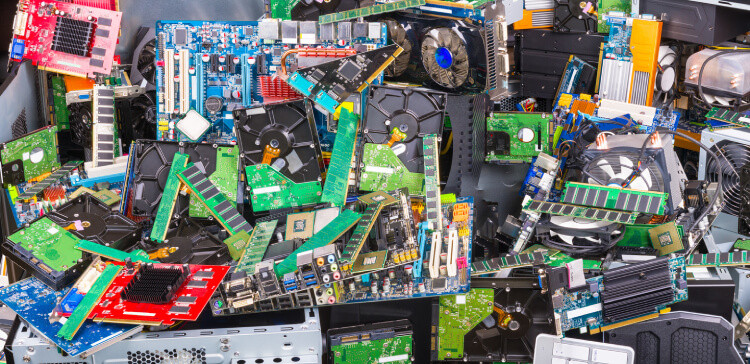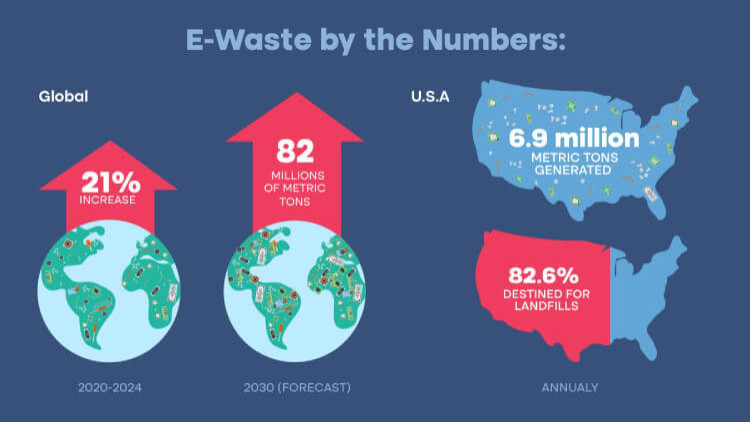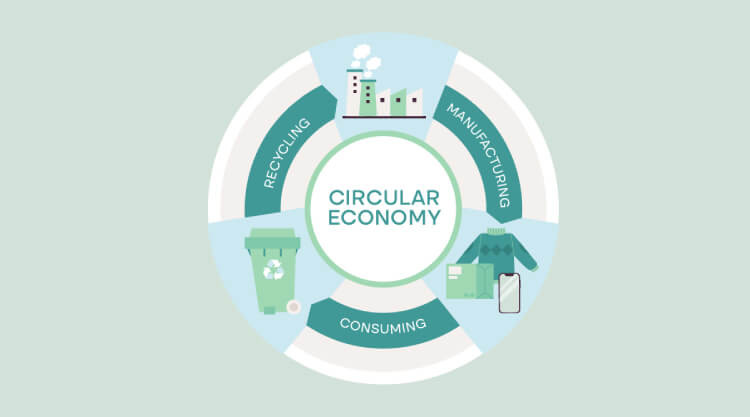E-waste Landfill Crisis: How Much Waste is Being Dumped?
Insights | 11-09-2024 | By Waldom Electronics

Key Things to Know:
- E-waste Generation: Global e-waste has reached 62 million metric tons annually, and it's still rising.
- Health & Environmental Risks: Toxic materials like lead and mercury leach into soil and water, harming ecosystems and public health.
- Low Recycling Rates: In the U.S., only 17.4% of e-waste is recycled, with 82.6% ending up in landfills.
- Circular Economy: Extending product lifespans and improving recycling can reduce e-waste and recover valuable resources.
Introduction
Imagine a towering mountain of discarded electronics, larger than the Great Wall of China. This massive pile symbolises the 62 million metric tons of e-waste generated globally each year. The growing problem of e-waste is staggering, and it's only increasing as our dependence on technology continues to expand.
The environmental and health impacts of this waste are dire. Toxic substances like lead, mercury, and cadmium leach into the soil and water, contaminating ecosystems. Polluted air from decomposing waste contributes to respiratory issues, further highlighting the urgent need for innovative, sustainable solutions.
The Growing E-waste Crisis: Global and U.S. Numbers
Over the past five years, global e-waste generation has surged by 21%, driven by the rapid pace of technological advancement and consumption. By 2030, experts project this figure will reach a staggering 82 million metric tons annually, presenting an ever-growing challenge.
The U.S. is a significant contributor, producing 6.9 million metric tons of e-waste each year. However, only 17.4% of this waste is recycled, with a shocking 82.6% ending up in landfills. These numbers emphasise the urgent need for improved e-waste management and greater public awareness of recycling practices.
Addressing this growing crisis requires systemic changes in recycling infrastructure, better regulations, and consumer education to reduce the amount of waste sent to landfills. Only through coordinated global and national efforts can we begin to reverse the damaging effects of e-waste on the environment and human health.

Consequences of E-waste in Landfills
The disposal of e-waste in landfills creates a toxic cocktail of harmful substances like lead, mercury, and cadmium, which leach into the soil and groundwater. These landfills, not designed to contain hazardous materials, contribute to pollution and the release of greenhouse gases, exacerbating climate change.
For human health, the risks are significant. Exposure to these toxic materials can lead to respiratory, reproductive, and neurological disorders, with children being particularly vulnerable.
In many developing countries, informal recycling practices expose workers to dangerous chemicals without proper protection, leading to serious health consequences. Moreover, when e-waste is left to rot in landfills, valuable materials like copper, gold, and rare earth elements are lost. These critical resources, essential for manufacturing new technology, are wasted, increasing strain on natural reserves and fueling geopolitical tensions over resource scarcity.
To mitigate these consequences, better recycling processes and systemic management are urgently needed.
The Role of a Circular Economy in E-waste Management
Shifting to a circular economy is key to addressing the e-waste crisis. This approach focuses on extending product lifespans, recovering valuable materials, and reducing waste. Sustainable product design is central, prioritising longevity, repairability, and easy disassembly to ensure electronics are used for longer periods.
Refurbishment and reuse programs allow electronics to have a second life, keeping them out of landfills. Proper recycling processes also ensure that valuable materials like metals and plastics can be recovered for new products. This model not only reduces environmental harm but also creates economic opportunities by fostering innovative recycling technologies and reducing reliance on finite resources.

Waldom's Green Stock Program: A Solution for E-waste Reduction
Waldom's Green Stock Program offers a practical solution for electronics distributors to actively participate in the circular economy. Through partnerships with both manufacturers and distributors, the program ensures price and brand integrity while reducing e-waste. Components reintroduced into the market undergo a rigorous inspection process, maintaining quality standards.
This program not only helps conserve valuable resources but also provides an opportunity for distributors and manufacturers to generate revenue from idle inventory. Waldom remains committed to a sustainable future where e-waste becomes a valuable resource, not a burden.
Conclusion: Call to Action
The e-waste crisis continues to pose significant environmental and health risks, making it crucial to address the issue with urgency. Embracing a circular economy is one of the most effective ways to mitigate these risks. Programs like Waldom's Green Stock offer tangible solutions by reducing waste, conserving resources, and creating economic value. It's time for manufacturers, distributors, and consumers alike to actively participate in these efforts and work towards a sustainable future where e-waste is no longer a problem but a valuable resource.

